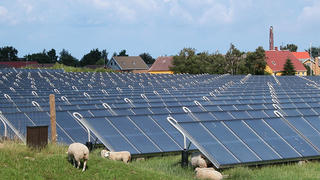How Does Seasonal Thermal Energy Storage Work?
5 min read
The main goal of seasonal thermal (STES) is to store energy produced during summer as and reuse it during the winter months to heat buildings. The thermal energy is stored deep underground or just below the surface.

© Erik Christensen – Wikimedia commons - In Marstal (Denmark), solar thermal panels heat water stored in a large pit before the heat is re-used in homes.
The Basic Principle
STES works by collecting “sustainable heat”, often produced by solar thermal panels, or “waste heat”, which is generally recovered from an industrial process and which would be lost under normal conditions. Captured when it is not needed, the heat is stored underground and is used several months later, depending on demand1. This technique, which is beginning to develop, is used in the housing sector to heat homes more economically. It is also used to cool homes, relying on systems that store the winter “coolness” and reuse it during the summer months.
An Example in Marstal, Denmark
Countries such as Denmark, Germany and Canada are particularly interested in storing thermal energy this way. The process can be applied to an entire eco-district or individual houses. (Denmark has more than 2,500 small systems.) Take Marstal in Denmark, for example, which in 2019 was home to the largest plant2.
With 2,300 inhabitants, Marstal is the largest town on the island of Ærø, located in southern Denmark. In the 1990s, the town started converting to renewable energies thanks to a wood-fired combined heat and plant and 33,000 square meters of solar thermal panels. These collectors capture heat, which is used to heat water stored in an underground pit measuring 75,000 cubic meters. The heat is used in the cool winter months, when there is little sunshine, supplying some 1,500 homes connected to the local grid. The main pit measures 113 meters by 88 meters at the surface, the size of a soccer field, and is 12 meters deep with gently sloping sides. It is filled with water, with layers of sand and clay, and is covered with insulating polyethylene, which supports temperatures of up to 80°C.
The Different Methods
The Marstal plant, with its shallow pit, is just one of many ways of storing thermal energy underground. The different methods can be broken down into two main types: underground storage and surface storage.
Underground storage
Hot water is stored at a depth of 10 to 15 meters underground or more. Then, well established
energy techniques are used.
The hot water is either introduced into a series of closed-loop boreholes3, or injected into a deep
.
For example, the Drake Landing eco-district in Okotoks, Alberta, Canada, distributes heat to 144 deep heating loops, located more than 37 meters below ground level with a surface diameter of 35 meters. The installation is covered with sand and clay, as well as an impermeable membrane, meaning that, by the end of the summer, the water can reach around 80°C.
In aquifer-based systems, groundwater heated on the surface is fed into a heat storage well underground. A geothermal doublet is used to extract and reinject the water. A project is currently under study in the Paris region, using the Dogger aquifer.
Surface storage
Hot water is held in pits (as is the case at Marstal), or in precast tanks buried underground for better insulation. For small systems, horizontal duct loops may be placed around buildings at very shallow depths.
Efficiency and Costs
According to data from the first systems, efficiency seems to be satisfactory and operating costs low. Efficiency, or the relationship between the heat used and the heat stored, is higher than 50%. Installation costs, however, can be high, meaning these techniques are typically used for new constructions.
(1) The Marstal network – https://www.solarthermalworld.org/news/denmark-23-mwth-cover-55-heat-demand-1500-households
(2) Borehole thermal energy storage (BTES)
(3) Aquifer thermal energy storage (ATES)





















